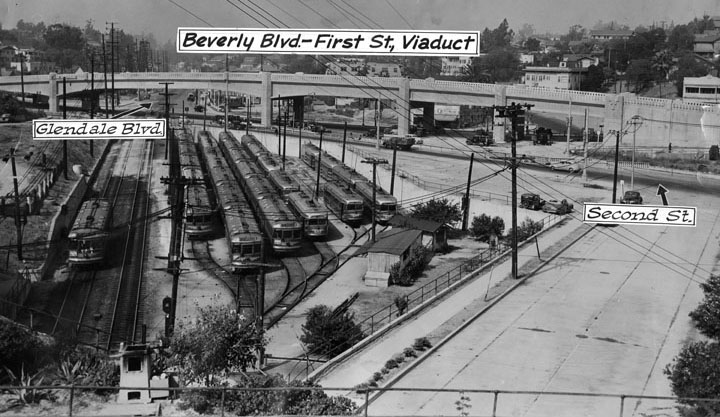The Beverly Boulevard/1st Street bridge is a bit of an anomaly nowadays, its graceful arc over Glendale Boulevard and 2nd Street seeming like literal and figurative overkill. But from this photo found — you guessed it! — in the LA Public Library digital archive you can see the span once served a more obviously cooperative purpose. Dated September 2, 1942, the image showcases the brand new viaduct about a week or so before the $1-million project was opened to cars.
Back then the city’s train routes were still being accommodated and included in the transportation grid by building auto infrastructure around or over them rather than destroying the rail lines wholesale for the sake of adding vehicular traffic lanes. With the Hollywood Freeway still about 8 years away from its first leg opening up, it’s easy to see the importance of Beverly Boulevard as a major artery getting people to and from the civic center. But if the Red Car hadn’t been there, it’s hard to imagine the city’s engineers going up when they could just carve out the connector at street level.
So over they went, crossing the roads along with the rails leading to and from  the yard in the foreground, which is Belmont Station. The photographer is positioned on the hill above the famed Belmont Tunnel that took cars entirely underground to and from the heart of downtown.
Long after the trains stopped running, the tunnel actually remained accessible to curious urban explorers, film and video crews, graffiti artists and the homeless until some five or six years ago. But the tunnel has been permanently blockaded, and where L.A. commuters once rocked, rolled and rumbled along those rails, now on the yard’s footprint this past couple of years has stood the Belmont Station apartment complex, its facade facing the anachronistic arch that’s liable to strike anyone who considers it as a curiosity, and whose purpose now (to those of us who know it origins) is to serve both highly as a monument to a time when rail ruled, and lowly as a footnote to the transportation history of a Los Angeles that forsaked integrating its multimodal past to instead embrace a short-sighted vision of its automobile-centered future.

 Follow
Follow